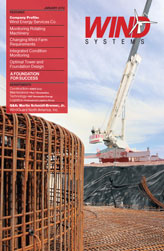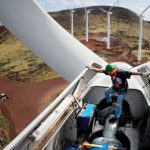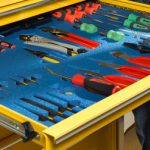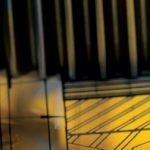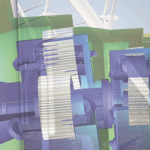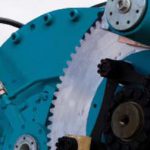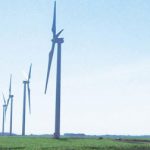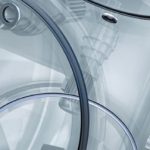Success or failure in construction is largely determined by how well risks are managed. Foundation system selection represents one of the largest risks to any project because of the inherent uncertainty that exists when working in the ground. This risk is never more critical than on wind farm projects where the project “site” covers many square miles and geotechnical conditions may vary drastically from one turbine location to another. For the maximum chance of success on any project, owners, designers and constructors must manage risks carefully by selecting foundation systems that are cost-effective, reliable and also adaptable to variations in geotechnical conditions.
Foundation Options
Foundation system selection needs to consider performance as well as construction cost and schedule. Even the most efficient foundation systems must also have sufficient flexibility to adapt to changes in conditions that may be encountered in the field during construction. Figure 1
The most efficient foundation scenario involves support of a turbine on competent soil at the design foundation bearing elevation. In this instance, a large concrete, inverted “T” foundation is used for turbine support. This approach represents one with the least expense and lowest foundation construction risk. Unfortunately, wind projects are sited in soil conditions that often exhibit insufficient support capacity to meet performance requirements and additional foundation support measures are needed.
One option in wide use involves over-excavation and replacement of poor soils. This approach requires large volumes of soil be excavated and removed at the tower location and the area is backfilled with thin, controlled lifts of high-quality engineered aggregate (similar to roadway construction material) prior to foundation construction. The tower foundations are then designed and constructed as the same inverted “T” foundations as those supported on natural competent soils. While this approach meets performance requirements if constructed properly, the risk of schedule delays and cost overruns remains high because of the potential for encountering high groundwater (requiring dewatering operations), inclement weather or deeper excavation requirements than anticipated to remove unsuitable soils.
Other options, in cases where the poor soils extend too deep for excavation, fall into the “deep” foundation category. Deep foundations are used to bypass thick zones of soft or compressible soils to transfer foundation loads to more competent bearing materials. These include driven piles, drilled piers (caissons), augercast-in-place piles, grout piles, and other forms of rigid inclusions. While these systems provide acceptable performance, tower foundation costs are typically much higher. These designs require thorough analysis to account for the behavior of the pile group under the complex turbine loads. Additionally, costs for deep foundations are often prohibitive because piles need to extend to depths sufficient to develop shaft resistance or bear on hard material (i.e. rock or hard glacial soil). Construction schedule risks exist from uncertainty of installation depths to reach bearing strata, low daily production rates, and difficulty with material delivery to the often-remote sites.
Intermediate Support
For more than a decade, many wind farm project teams have reduced performance and construction risk and saved time and money by considering support solutions beyond the traditional construction approaches. Rammed Aggregate Pier® (RAP) systems designed by Geopier Foundation Company have provided support for structures for over two decades. These Intermediate Foundation® systems have been used extensively on wind projects in the United States, Canada, Mexico and in Europe. Figure 2
The concept involves densifying or reinforcing poor soils through the installation of stiff aggregate piers that uses high frequency vertical ramming energy during construction. Installation of RAP elements is accomplished by either replacement (Geopier® system) or displacement (Impact® or Rampact® systems) construction techniques to depths of up to 45 feet. The replacement system involves drilling a 24-36 inch diameter cavity depending on design requirements; placing thin lifts of aggregate within the cavity and vertically ramming the aggregate using a high-energy patented beveled tamper. The displacement system involves driving a specially designed mandrel and tamper foot into the ground using a strong static crowd force augmented by dynamic vertical impact energy. After driving to design depth, the hollow mandrel serves as a conduit for aggregate placement. Figure 3 Aggregate is placed inside the mandrel and delivered to the tamper head. The mandrel is then raised approximately three feet and then driven back down two feet, forming a one-foot thick compacted lift. Compaction is achieved through static down force and dynamic vertical ramming from the hammer.
During construction of each RAP system the high frequency energy delivered by the hydraulic hammer, combined with the beveled shape of the tamper, not only densifies the aggregate vertically to create a stiff aggregate pier but also forces aggregate laterally, resulting in lateral stress increase in surrounding soil. The lateral stress increase reduces the compressibility of the surrounding soil and promotes positive coupling of the RAP element and the soil to create an improved composite, reinforced soil zone.
The system reinforces poor soils, which improves the bearing pressure of the reinforced zone beneath turbine foundations, controls total and differential settlement (angular distortion) of the foundations and improves the rotational and dynamic stiffness values to achieve the desired turbine performance. The soil reinforcement designs are developed on a project-specific basis depending on site and tower loading conditions to support shallow inverted-T foundations, like those bearing on engineered fill or competent native soils. The use of the intermediate solution eliminates the need for massive over-excavation or deep foundations and also allows for adaptability in construction based on soil conditions encountered at the site. Figure 4
Challenging Sites Demand Flexibility
Recently, engineers with HDR Engineering, Inc. (HDR) were faced with the challenge of designing a large wind farm in Franklin County, Iowa. The project involved the design and construction of 121 wind towers traversing 33,000 acres, or about 51 square miles. The project featured Vestas V82 model turbines, with 80-meter hub heights, capable of generating 1.65MW of power.
Working with the project geotechnical engineers (Terracon), the design team determined that the foundation risks for many sites could be managed cost-effectively by supporting towers on octagonal inverted-T foundations bearing on competent soils or perhaps limited areas of shallow over-excavation. Multiple, different-sized tower designs were prepared to accommodate the different soil conditions and variation in maximum allowable soil bearing pressures from site to site. Figure 5
Typically, when over-excavation depths exceed three or four feet below the foundation, alternative approaches become more cost-effective. Many sites across the 51 square miles encountered these conditions where the shallow foundation option bearing on native soil was inappropriate. HDR and Terracon, working with Geopier engineers, found a solution by using an intermediate RAP approach to provide acceptable performance and keep foundation costs under control while utilizing the existing shallow foundation designs prepared by HDR. The soil conditions requiring reinforcement ranged from soft to stiff clay with occasional silt and sand layers to thick deposits of loose clayey sand, silt and sand. With variable soil conditions and groundwater levels as shallow as three feet at some sites, multiple RAP construction approaches (replacement and displacement) were required. The versatility of the Geopier technologies ultimately resulted in a solution for 37 tower sites.
Once selected, prime contractor RMT, Inc. utilized the RAP system constructed by licensed installer Foundation Service Corporation, Inc. (FSC), of Hudson, Iowa. During detailed design FSC and Geopier identified each site as either a replacement (Geopier approach) or a displacement (Impact) approach. Different RAP design approaches were then developed based on the different soil conditions for each site. The soil reinforcement designs incorporated a grid of RAP elements ranging between 56 and 100 piers per turbine site with piers extending 9-17 feet below the footing to reinforce the poor soils.
Construction of the RAP systems at each site was typically completed within two to four days depending on the installation method and soil conditions encountered. In some instances, unexpected variations in soil conditions resulted in the need to adjust installation methods. Fortunately, the RAP systems afford the flexibility to modify the construction approach (displacement Impact or replacement Geopier) with rapid changes to the RAP design made in a day or two and no subsequent structural design changes to the foundations. These adjustments allowed the project to continue moving forward to meet schedule goals despite unexpected variations in conditions.
Quality control testing on the project included the performance of full-scale modulus load testing to evaluate the response of the pier under applied stresses. Measurements confirmed the pier stiffness met or exceeded the design requirements when loaded to pier stress levels more than four times the maximum foundation stress.
Summary
Rammed Aggregate Pier systems are now commonly used for foundation support solutions on turbine sites across the Americas and Europe as a means to manage geotechnical risks and provide superior construction and performance. This intermediate foundation approach reinforces a variety of poor soil conditions, allows the use of cost-effective inverted-T foundations and provides flexibility during construction to make construction/design changes based on conditions encountered at specific sites to help maintain schedules. With over 1,000MW of towers supported, Rammed Aggregate Pier systems are fast becoming a preferred foundation support solution to manage geotechnical construction risks and deliver successful time and cost-saving solutions.



















